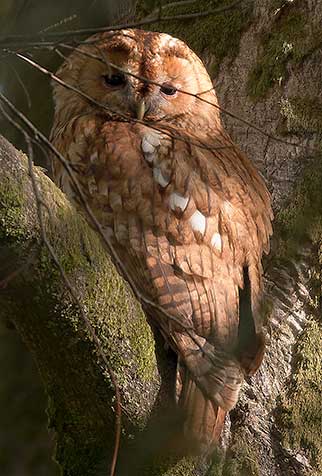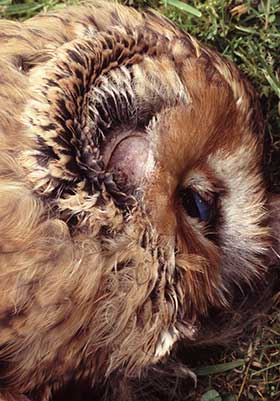Tawny Owl (Strix aluco)
When: All year round
How many: Widespread and relatively abundant

dappled woodland light
If asked to nominate the New Forest’s most abundant bird of prey, few would probably say the Tawny Owl. Yet it’s true – the Tawny Owl is by far the most numerous.
Largely silent, highly effective killers of the night, Tawny Owls are elusive during the hours of daylight, content to roost in tree holes or cavities; or pressed up against the trunk of broad-leaved or coniferous trees where they depend on cryptic plumage patterns and colouration for concealment from the attentions of mobbing smaller birds.
Tawny Owls do, though, like a bit of warmth, particularly in the colder months, and have been observed sitting atop conifers, taking in the sunshine; and perched until mid-day in the entrance to roost cavities.
But mostly, the presence of these birds is betrayed only by their well-known dusk vocalisations as birds rise from slumber and declare themselves to mates and neighbours in what amounts to a dawn chorus in reverse.
Long, wavering hoots are often heard, and sharp ke-wick calls, also. Cat-like screams – caterwauls - are also a common feature of Tawny Owl boundary disputes, but perhaps the least known yet most appealing call is a soft, bubbling purr audible only at relatively close range, a soporific, affectionate sound that drifts gently through the trees, catching well the mood of calm, night-time woodlands.
Used by both male and female owls, the 'bubbling purr' can be heard in all months of the year, although in my experience, it is most commonly encountered during the early part of the breeding season - in February, March and April - and again in August as youngsters disperse and territorial boundaries are re-established.
The Tawny Owl's rounded face, with what many consider to be a wise expression, presents a benign appearance, but these birds are actually violently efficient killers, superbly adapted for their preferred way of life, for hunting from a perch and rapidly dispatching prey. Indeed, they've been most appropriately likened to cats with wings.
Their feathers are covered in soft, velvety down, whilst the edges of the primaries are fringed with short, fine bristles, features designed to silence the rush of air in flight. Feathered legs also assist a quiet approach and, maybe, provide winter warmth. A huge hooked bill is largely concealed amongst a bundle of loose facial feathers, whilst their enormous gape provides capacity for swallowing whole, creatures as big as rats.
Large, highly sensitive, forward facing eyes with enormous light-gathering power give Tawny Owls binocular vision that helps when judging distances.
Their hearing is also particularly acute, and, indeed, can be said to be the owl’s secret weapon, enabling effective hunting on even the darkest of nights. Huge ear orifices, each of slightly different size and shape, are asymmetrically positioned just behind the facial disc. Hidden amongst the feathers, they’re covered by a flap of skin that can be lifted at will, just as can the facial disc, as the bird strains to hear the slightest rustle that might reveal presence of mouse or vole on the woodland floor below.
Then long, razor sharp talons offer little chance of escape before that vicious bill is brought into play.

Regurgitated pellets provide clues to diet – prey is swallowed whole, stomach acids break down the digestible parts, whilst indigestible bits of bone and teeth, for example, are regurgitated.
Regurgitation is not, though, from regular perches, so finding pellets can be a challenge. But the effort is worthwhile as both a guide to diet, and also as an indicator of the small mammal populations present.
Such studies show that Tawny Owls are generalists, creatures that will eat just about any edible animal matter, so that if one food source is in short supply, they can switch to another. Indeed, they have adopted a very sedentary, highly territorial way of life, rarely travelling far at all, staying year-round in a relatively limited area where they get to know every nook and cranny - the best places to hunt, and the best places to rest.
Prey items include field voles, bank voles, wood mice, rabbits, rats, small birds and even bats. In my own New Forest study, the most frequently found items, however, were dung beetle wing cases and other beetle bits.
Yet despite the varied diet and access to primarily grass-eating field voles, New Forest Tawny Owl breeding success fluctuates markedly with the autumnal seed and mast crop, suggesting significant reliance on small, seed and mast-eating mammals. After the very heavy 2004 mast crop, for example, in three woods, virtually all pairs – 12 in all - fledged large broods of noisy, incredibly inquisitive youngsters. But in 2006, after a poor mast and seed crop, a lower proportion of pairs fledged young, and those that did, had broods that were very quiet, suggesting smaller brood sizes.
Numbers of breeding territories, though, remain remarkably constant, confirming a stable, incredibly adaptable underlying population that survives at high density, augmented following strong mast and seed years by large numbers of youngsters.
References:
Collins Bird Guide: Killian Mullarney, Lars Svensson, Dan Zetterstrom and Peter J.Grant
Handbook of the Birds of Europe, the Middle East and North Africa, The Birds of the Western Palearctic (volumes 1-9): Stanley Cramp, et al
The New Forest – A Natural History: Colin R. Tubbs
More links
Other related links
Search this site

Sadly, 58 animals were killed - 35 ponies, 13 cows, 8 donkeys and 2 sheep, whilst a further 32 were injured - 3 pigs, 9 donkeys, 11 cows and 9 ponies.
(Forty-three accidents occurred in daylight, 15 at twilight and 101 in the dark. Twenty-seven accidents were not reported by the driver involved).
Here's just one horrific example - Three donkeys killed in collision with van at notorious New Forest blackspot (Advertiser and Times)

